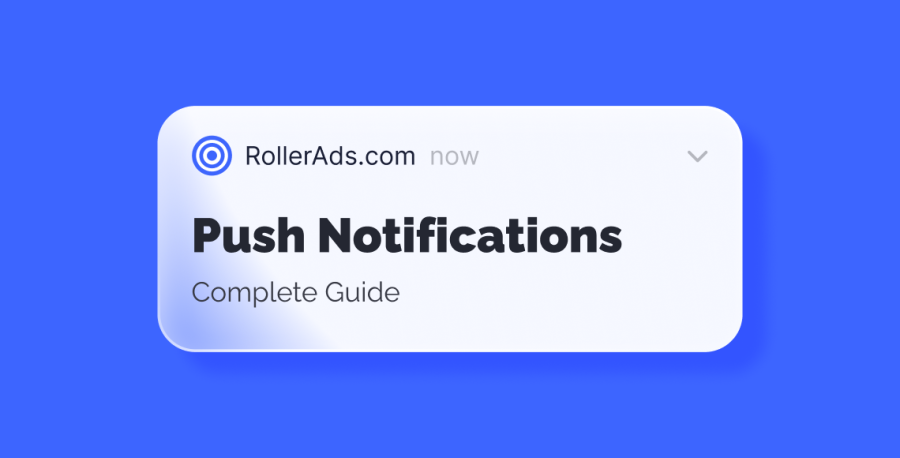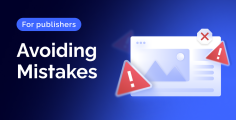Every now and then push notifications are proclaimed to be dead, over and over again. Yet, few marketers are willing to give up on these tiny pop-uppers. Push notifications are easy to establish, cheap, and reliable like a Swiss watch, which is why they refuse to fall into oblivion.
RollerAds specializes on a few ad formats, and push notifications are among them. However, push rush is generally a bad idea — read the article to learn why. You will also get to know the types of push notifications, their applicability, best practices — everything you might need for your campaigns.
Types and Advantages
Businesses interact with the customers via push notifications for a reason… a couple of to be exact:
- Low cost, which can be as small as $0.01 per click
- Supreme delivery rate of 100% thanks to no ad blockers
- High engagement rate of up to 90% of the audience
- Opt-in rate of 81% for Android and 51% for iOS
- Increased Click-Through Rate (CTR) of up to 8% (compare: 1–2% for e-mails)
Technically, pushes can be classic and in-page ones. The former delivers the message to the device itself, while the latter functions within a browser. In-page pushes are perceived as less intrusive but are unable to prompt at any time. Push notifications can be different in their intention as well:
- Transactional — triggered automatically, after some kind of interaction with the product, e.g., credit card data input
- Informational — can also be triggered but mostly are manual and generally inform about some product updates, e.g., a change in monetization model
- Promotional — as the name suggests, they are used for sales, discounts, new services
- Follow-ups — almost a third of the users delete an app after installing within a month and “win-backs” are the key to retaining the user and improving product awareness
Knowing the purpose of your push notifications is just a step towards developing a push strategy. An affective push campaign requires a few steps to be taken.
Effective Campaigning
Besides specifying the goals of your campaign, you need to know your target audience. Considering that generic messages please no one, you have to segment the target audience and address each group personally. Start off with elaborating on the ideal customer persona. Specify such things as age, gender, demographics, behavior, preferences — the more, the better. This persona will be used for comparison with the actual audience to guide you and your campaigns.
Nowadays, the task of finding a person fully free from social networks is harder than looking for a needle in a haystack. But social networks enjoy unequal popularity among different social groups, e.g., after the age of 35 the interest for Instagram plummets. Therefore, use the right social networks for your push campaigns.
Moreover, the target audience has a specific set of words that might not be applicable for other segments. For instance, Redditers can write in an official, patronizing manner; Dota 2 gamers can use special slang, which can differ from the mainstream, e.g., CS = creeper score, not Counter-Strike. Consequently, be very careful whenever you are trying to sound native.
Push notifications might be short, but it does not imply you can forget about proper user experience (UX). Push notifications must be succinct, following a certain set of characteristics:
- A header of up to 65 symbols
- A message body not longer than 240 characters
- Some links to follow
- An image (the user is not in a library, after all)
The worst thing you can do for the UX is to barrage your audience with pushes. Your line of work dictates the frequency of pushing. For instance, an online store can get away with sending a push or two per day. At the same time, the audience of an online service would consider such frequency an intrusion, which is why a couple of pushes should be reserved per week.
Furthermore, the time of the day makes an impact too. According to the Business of Apps study, the optimal ranges for pushing are from 11 a.m. to 3 p.m. and from 5 p.m. to 11 p.m.
Source: Business of Apps
If only wrong timing was the only problem… Push notifications ought to be visually appealing and platform matching too. Learn more about the eye-pleasing color combinations, using the Itten’s color circle. Don’t forget about personalizing your ad as well, because good design is not limited to visuals and includes the message too.
Best Practices and Worst Wrongdoings
To make things easier, we decided to compile a whitelist and blacklist of things to keep in mind when making your push campaigns. For starters, we will focus on the best practices:
- Creation of a customer persona (better targeting)
- Selection of the right platform (better targeting)
- (Optional) Choice of the right advertising network (less headache)
- Personalized approach (better UX, CTR, and conversion rate)
- Succinct message (better UX)
- Platform-native and mutually-complementing colors (better UX)
- Clear, user-humbling, and mistakes-free language (better UX)
- Field-testing before full-scale campaigning (more data)
- Data gathering and push database collection (better performance)
It’s always good to have your very own push database, because you will be completely in charge of when and what messages to send (no moderation). Best practices are basically the opposite of how-not-to-do. Nonetheless, we will still name the most significant points that you should remember before pushing too far:
- Generic approach and no audience segmentation (show some respect)
- Too many and too frequent notifications (use previous data and/or test)
- Push notifications for irrelevant offers (test first)
- Lack of optimization for different devices (don’t be lazy and test)
- Pushes that inevitably catch up with the user’s turned off device, once it is powered on again (specify the timespan of pushes’ life)
- Pushing the limits with creativity (e.g., How much do you weigh? Do you like it? Neither do we. Okay-okay, here is your discount for our gym — too patronizing)
- Push spamming due to the bugs and code malfunctions (test first)
- Failure to notify the user about pushes being turned on by default, especially when they have a distinct sound (test, inform, start off muted)
Push notifications are an invaluable tool in affiliate marketing, yet they ought to be used sparingly to keep the user hooked and not spooked. Treat your users with due respect, and you will be able to avoid the majority of the pitfalls above.
Instead of conclusion
Initially, we wanted to conclude with the summary above. But ultimately, we decided against it, because there is one more thing to tell you.
RollerAds provides you all the tools needed for detailed customization of your push campaigns. Our targeting options include but not limited to IP range, traffic quality, GEO, subscription age, and connection type. But if you tolerate no excuses and strive for the ultimate performance, try out TheSender, a push notification platform with advanced customization and personalization features.
Why should you trust our “unwarranted” claims about TheSender? Because they are, in fact, backboned with a case study. We will skip the details here due to the space constraints, but the results of the case were as follows:
- Average monthly revenue has grown up to $6000.
- Monetization has brought up to 70% more value.
- For over half a year everything has been working and making money automatically.
Long live the pushes! Ahem, we mean… the eternal life of ever dying push notifications continues. And we have a vast expertise in putting that life to good use. Contact RollerAds if you need any help with your push campaigns, and remember — classics never get old, just a little… dusty.





